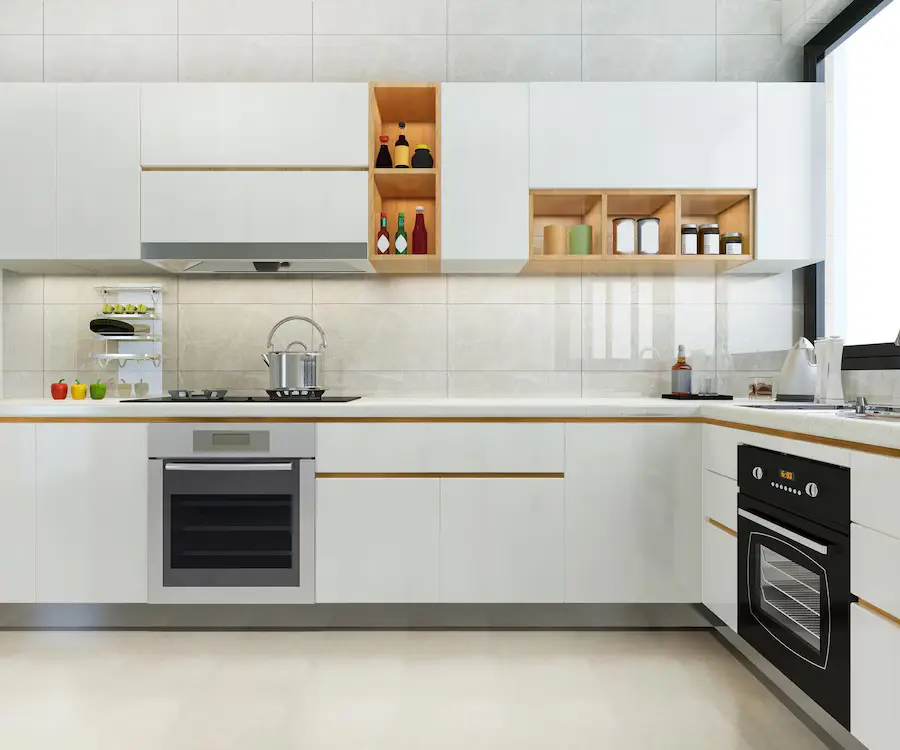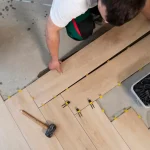The kitchen is often the heart of the home, where meals are prepared, conversations happen, and memories are made. One way to transform this vital space is by upgrading your flooring. Not only can new floors enhance the overall aesthetics, but they can also improve functionality and add value to your home. As Emily Henderson, a renowned interior designer, puts it, “The right flooring can elevate your kitchen from functional to fabulous. Consider factors like style, durability, and water resistance to create a space that’s both beautiful and practical” .
Understanding Your Flooring Options
When choosing flooring for your kitchen, it’s essential to consider the various options available and their specific benefits. Let’s explore some of the most popular kitchen flooring materials and their unique features.
Tile
Tile flooring is a classic choice for kitchens due to its durability and water resistance. Available in a wide range of styles, colors, and patterns, tiles can complement any kitchen design.
Pros:
- Highly durable and long-lasting
- Resistant to water and stains
- Easy to clean and maintain
Cons:
- Can be cold and hard underfoot
- May require professional installation
- Grout lines can accumulate dirt
I remember visiting my grandmother’s house, where the kitchen had beautiful ceramic tiles. They always felt cool under my bare feet, especially during the hot summer months. Plus, any spills were quickly wiped away without leaving a trace.
Luxury Vinyl Plank (LVP)
Luxury vinyl plank (LVP) has gained popularity due to its realistic appearance and excellent performance in high-moisture areas like kitchens. It mimics the look of wood or stone but is more affordable and practical.
Pros:
- Water-resistant and durable
- Comfortable underfoot
- Available in various styles and colors
Cons:
- May not add as much value as natural materials
- Can be susceptible to scratches
Sarah Lee, a flooring installation specialist, recommends LVP for kitchens: “For kitchens, prioritize water resistance! Opt for materials like tile, luxury vinyl plank (LVP), or waterproof laminate to handle spills and splashes.”
Hardwood
Hardwood flooring brings warmth and elegance to any kitchen. While it’s traditionally seen as a living room or bedroom material, with the right precautions, it can be an excellent choice for the kitchen as well.
Pros:
- Timeless beauty and high resale value
- Can be refinished multiple times
- Adds warmth and character
Cons:
- Sensitive to moisture and spills
- Requires regular maintenance
In my home, we opted for hardwood floors in the kitchen. Initially, I was concerned about potential water damage, but with proper care and promptly cleaning up spills, the floors have remained beautiful and scratch-free. The natural look of wood adds a cozy feel to our kitchen.
Laminate
Laminate flooring is another budget-friendly option that can mimic the appearance of wood or stone. It’s relatively easy to install and maintain.
Pros:
- Affordable and easy to install
- Available in various styles and finishes
- Resistant to scratches and stains
Cons:
- Not as water-resistant as other options
- Can feel less authentic underfoot
Cork
Cork flooring offers a unique blend of comfort and sustainability. It’s soft underfoot, making it ideal for long cooking sessions, and it’s also eco-friendly.
Pros:
- Comfortable and resilient
- Naturally anti-microbial and hypoallergenic
- Environmentally friendly
Cons:
- Can be susceptible to water damage
- Needs periodic sealing
Tile Look-Alikes
Porcelain and ceramic tiles that mimic the look of natural materials like wood or stone are also popular. They offer the aesthetic appeal of more expensive materials with the practical benefits of tile.
Pros:
- Durable and water-resistant
- Available in many designs
- Easy to maintain
Cons:
- Can be hard and cold underfoot
- Professional installation may be required
Design Considerations
Choosing the right flooring involves more than just picking a material. You also need to consider the overall design of your kitchen and how the flooring will integrate with other elements.
Color and Pattern
Don’t shy away from adding a pop of color or a bold pattern to your kitchen floor. Michael Johnson, a home improvement blogger, suggests, “Don’t be afraid to add a pop of color or pattern! Bold tile or patterned LVP can create a statement backsplash or define the kitchen workspace.”
For instance, a checkerboard tile pattern can give a retro vibe, while a bold, geometric pattern can add a modern touch.
Seamless Transitions
If you have an open floor plan, David Jones, an architect, advises, “Open floor plans benefit from cohesive flooring that flows seamlessly from the kitchen to adjoining areas. This creates a sense of spaciousness and visual connection.”
Choosing a consistent flooring material throughout connected spaces can make your home feel larger and more unified.
Practicality
The kitchen is a high-traffic area prone to spills and messes. Therefore, selecting a flooring material that’s easy to clean and maintain is crucial. The National Kitchen & Bath Association (NKBA) highlights this point: “Consider the cleaning needs of your chosen material. Busy kitchens might benefit from low-maintenance flooring options that resist dirt and grime” .
The Impact of Kitchen Flooring on Home Value
Investing in high-quality kitchen flooring can significantly enhance your home’s value. The National Association of Realtors (NAR) notes, “Investing in high-quality flooring not only enhances aesthetics but also increases your home’s value. It’s a win-win for style and resale potential” .
A 2024 study by a real estate research group, “The Impact of Kitchen Flooring on Property Value,” found that homes with updated kitchen flooring tend to sell faster and at higher prices. This underscores the importance of choosing flooring that not only looks good but also appeals to potential buyers.
Sustainability Considerations
For environmentally conscious homeowners, sustainability is an important factor when selecting kitchen flooring. A 2022 study by a university environmental science department, “Life Cycle Assessment of Kitchen Flooring Materials: Sustainability Considerations,” compared the environmental impact of various flooring materials from production to disposal.
Cork and Bamboo
Cork and bamboo are excellent choices for eco-friendly flooring. Cork is harvested from the bark of cork oak trees, which regrows after harvesting, making it a renewable resource. Bamboo, technically a grass, grows quickly and can be harvested without harming the plant.
Recycled Materials
Many manufacturers now offer flooring made from recycled materials, such as recycled glass tiles or reclaimed wood. These options reduce waste and promote sustainability.
Personalizing Your Kitchen Floor
Your kitchen floor can be a reflection of your personal style. Here are some tips to make your kitchen flooring uniquely yours:
Custom Inlays and Borders
Add a custom touch with inlays or borders. This could be a different color tile border around the kitchen island or a mosaic tile inlay near the sink area. These small details can add a lot of character and make your kitchen floor stand out.
Area Rugs
Using area rugs in the kitchen can add warmth and comfort, especially in front of the sink or stove where you spend a lot of time standing. Choose rugs that are easy to clean and coordinate with your kitchen’s color scheme.
Conclusion
Transforming your kitchen with stunning new floors is an exciting home improvement project that can make a significant impact. By considering factors such as style, durability, water resistance, and maintenance, you can choose the perfect flooring that not only enhances the beauty of your kitchen but also meets your practical needs.
Remember the insights from experts like Emily Henderson and Sarah Lee, and consider the various options available to you. Whether you choose the timeless elegance of hardwood, the practicality of tile, or the modern appeal of luxury vinyl plank, your new kitchen floors can truly elevate the heart of your home.
So, take the plunge and invest in quality flooring that will bring joy, functionality, and value to your kitchen for years to come. With thoughtful selection and care, your kitchen floor will not only look stunning but will also serve as a durable foundation for all the cherished moments and delicious meals to come.










